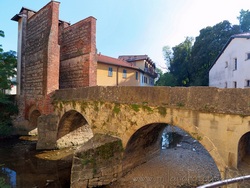|
Vimercate (Monza e Brianza, Italy): Bridge of San Rocco
|
|
|
Show an other place around Milan worth a visit: |
 The San Rocco bridge complex, the only Lombard example of a fortified medieval bridge, is perhaps the most famous historical artistic asset of Vimercate because in the nineteenth century, at the time of neo-gothic and neo-Romanesque fashion it reflected very well the tastes of the epoch, and so it was the subject of numerous representations and become the symbol of the city. For this reason it was the only city gate not to be demolished during the nineteenth century. The San Rocco bridge complex, the only Lombard example of a fortified medieval bridge, is perhaps the most famous historical artistic asset of Vimercate because in the nineteenth century, at the time of neo-gothic and neo-Romanesque fashion it reflected very well the tastes of the epoch, and so it was the subject of numerous representations and become the symbol of the city. For this reason it was the only city gate not to be demolished during the nineteenth century.
The complex is characterized by having performed a double function: that of a bridge over the Molgora stream and at the same time that of village gate.
It is based on a Roman bridge, built in the third century AD. along the road that led from Vimercate to Trezzo.
In the twelfth century, the internal door was added, i.e. the one towards the village, with a defensive function (it was in fact integrated with the city walls) and originally called Porta di Moriano (Gate of Moriano).
In the fourteenth century the eastern gate was added, i.e. that towards the countryside, and the internal one was raised.
At the beginning of the sixteenth century the structure was modernized and it changed its name, acquiring that of Porta di San Rocco (Gate of Saint Rocco), by virtue of the presence not far from it of a chapel dedicated to that saint.
The actual bridge is 28 meters long, consists of four arches and contains original Roman elements. Originally the bridge was longer and as the flow rate of the creek was greater than today more stacks were provided with a fornix above them. Currently only the stack closest to the town has an opening above it.
Both gates consist of towers with one side (the one facing the village) open.
The western tower, that is the one towards the village, has a trapezoidal plan (Fig. 2, 3). The base of the twelfth century and the elevation of the fourteenth century are well recognizable.
The portal is defined by two concentric arches: one in brick, more exterior, and one in stone, inside. To be noted that in one of the two blocks next to the keystone, there is a small human protome, the only surviving element of the ancient decoration.
The two windows on both sides were used to access the walkways of the city walls, now no longer existing, while the hanging arches on the top were equipped with drains to allow stones and hot liquids to fall on the attackers.
The eastern gate (Fig. 1), i.e. the gate to the countryside, was built in the second half of the fourteenth century, but its current appearance is due to the interventions of the late sixteenth century.
With a rectangular plan it has a brick façade without openings and side walls made of bricks and river pebbles with various slits: two upper and four lower ones (on each side).
This tower originally served as a ravelin, a fortified outpost. In fact, the positions and inclinations of the various slits were chosen in such a way as to allow an adequate defense against enemies both still far away and already near the tower.
On the façade were painted in 1856 by Gaetano Barabini frescoes, now disappeared, of Saint Stephen, patron saint of the city, between the saints Rocco, protector of plague victims, and James, protector of travelers.
Internally in both towers are still recognizable the holes in the walls, in which the beams were inserted that served to support the scaffolding that allowed to reach the upper parts.
Categories: Places of historical value
Via Camillo Benso Cavour, 20871 Vimercate MB |
Further pictures of Bridge of San Rocco in the section Photography |